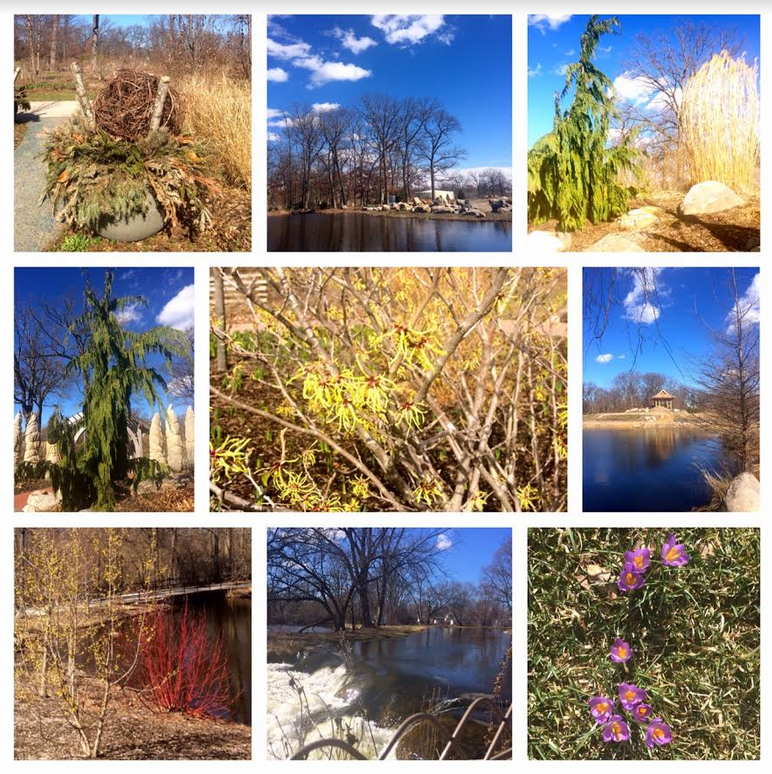Glimpses of Healing and Hope
March 13, 2017
By: Jane Bishop Halteman

'There is no end to things that can awaken our wonder'
(Wellfield Botanic Gardens showing signs of spring last week)
As people of faith, we trust that the Divine, the great Mystery, is present with us in our wondering. In response to an invitation from worship planners that I share on wonder during the Lent 2 service Sunday, I did a lot of wondering last week about whether I should address wonder the noun, as in awe and wonder, or wonder the verb as in “I wonder why that happened to me, to us, to our country, to the world.” I came up with this amalgam of the ways wonder has impacted me over the years.
When I was very young, my wondering and sometimes wandering mind, of its own volition, it seemed, tended toward negative wonderings based on some of the things I was taught as a child…I was preoccupied with questions like “would I be good enough to go to heaven,” “would the second coming take place before I was old enough to get married or have children,” “would someone close to me die prematurely?” None of these wonderings brought me to a place of happiness, and I became an anxious child. Eventually I wondered how I would continue to navigate my life when my boyfriend died in a truck accident after my sophomore year of high school and again after my 18-year-old brother died in a car crash when I was 28.
The births of our two children in the 1970s brought good wonder, as in awe, to my life and, in the mid-90s, when I first began to receive spiritual direction, I became acquainted with authors who taught me more about the positive side of wonder. Flora Slossen Wuellner’s writing revealed that tended wounds can become sources of new life and the channel of healing for others: that fear when healed becomes compassion, that destructive anger becomes a passion for justice and righteousness, that perfectionism becomes joyous power to build and create.
Other amazing writers, like Jan Richardson, offered wondrous new learnings including the observation that each “moment holds the possibility of encountering the sacred. Waking, eating, reading the paper, working, playing, talking, doing laundry, doing dishes, doing errands, doing nothing”…all of these interactions invite us to wonder how God is with us and who God becomes for us.
In my older age, positive wonder comes much more easily with four grandchildren now on the scene who open the door to delight in many age-appropriate ways as they learn and grow. Nature has taken on a robust capacity to offer seasonal awe and wonder. My love of writing and photography continues to accelerate in these retirement years. I am awed by the privilege of journeying with directees and sharing community with family and friends.
As G.K. Chesterton suggests, “At the back of our brains, so to speak, there (is) a forgotten blaze or burst of astonishment at our own existence. The object of the artistic and spirited life (is) to dig for this submerged sunrise of wonder.”
For more on wonder as a spiritual practice, I searched the Spirituality & Practice website, where authors Frederic and Mary Ann Brussat note that “wonder begins in the senses, comes alive in the imagination, and flourishes in adoration of the Divine….There is no end to the things that can awaken our wonder, from the majesty of the night sky to the smell of lilacs in the spring to the turning of the leaves in the fall. And it is all right here, a feast of epiphanies and astonishments in the daily round of our spiritual lives.”
In its review of The Zen of Seeing (Seeing/Drawing a Meditation) by Frederick Franck, the website points out that “where there is revelation, explanation becomes superfluous. Curiosity is dissolved into wonder.”
The site also offers this Mark Nepo book excerpt from The One Life We’re Given on the practice of cultivating wonder and this link to an excerpt from Robert C. Fuller’s Wonder from Emotion to Spirituality. Nepo suggests that “our challenge is not to choose between the fragility and strength of life but to cultivate our wonder by holding both in our heart. Life is fragile and unbreakable. We teeter and we soar; often at the same time. Wonder helps us find the indestructible part of the thread.”
Fuller says this: “We can efficiently go through life without delighting in experiences of wonder. Many people do. But it must also be emphasized that no other emotion so effectively induces us to pause, admire, and open our hearts and minds. No other emotion so readily kindles a reverence for life.”
How might you further develop the practice of wonder as a spiritual discipline this Lenten season? Consider your past experiences of wonder and how they have changed you. Determine the places in your life most likely to arouse wonder and resolve to spend time in those places this Lenten season.